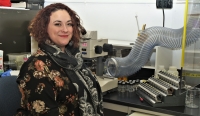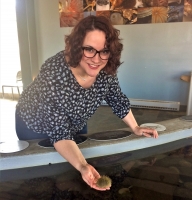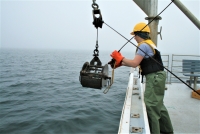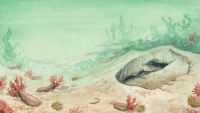
Crystal Hiltz,
Taxonomic Technician
Crystal Hiltz is a Taxonomic Technician at the Huntsman Marine Science Centre in St. Andrews, New Brunswick. She uses physical characteristics to identify marine animals and plants. This work adds to our understanding of the diversity of life in our oceans, and the impact of both natural and human actions.
Dive DeeperMarine Career Interview
What do you do?
I’m a taxonomist in the Huntsman’s Taxonomy and Biodiversity research laboratory. In this laboratory we focus on biodiversity. We’re interested in all the species that make up different marine communities. We look at how they change over distance, time, and with environmental conditions. The main part of my job is identifying species in samples. These are often mud grab samples of the seabed and I look at the tiny animals that live inside the sediment.
What projects do you work on?
We receive samples from all over, even the Arctic and Antarctic, as well as from the bay outside our lab windows. Some samples are sent to us from institutions that may not have the taxonomic expertise to identify them themselves. We collect others to answer our own specific biodiversity questions. Part of our work is to maintain and grow our natural history museum. Here we keep a representation of as many species as possible from the Canadian North Atlantic.
Why is identifying things important?
In the scheme of our work in biodiversity, identifying things is important so we know what’s in an area. If we sample the same area over many months or years, we can track any changes that may occur in what creatures live there. This gives us a good idea of how a community changes over time, and some hints about why those changes are happening. For example, sea temperatures are rising. Records from our identifications can show if species are moving into new areas, possibly due to this rise in temperature. In the greatest sense, identifying things is important because it helps us understand our natural world. As humans, we want to categorize everything: find a thing, give it a name, and know where it fits in the grand scheme. We can’t do that without taxonomy.

Identifying tiny marine organisms involves a lot of detailed microscope work. (Photo: Claire Goodwin)
How do you go about identifying something?
Identifying things starts with the broadest strokes, becoming more detailed as you progress. First I start with a specimen, and I look at its general appearance: e.g. its shape, or how many legs it has (if any). I use this information to sort it into the correct major group (phylum) and choose the right identification reference.
What resources do you use to help you?
At the Huntsman we have all sorts of books and articles we use that cover all the different animal and plant groups. These references will usually contain pictures and a dichotomous key. This is a series of choices that lead the user to the correct ID using the characteristics of the specimen. Each step in the key eliminates options, bringing me to the final identification, or the species. Sometimes it isn’t so straight-forward, and I have to go digging for papers with old species descriptions or new revisions to groups. Sometimes we find we have a species new to science, which is very exciting, but you won’t know that unless you eliminate all the other options first.
What does your typical day involve?
The things I work on are very small, so large portions of most days are spent at the microscope, identifying marine species. My specialty is in benthic invertebrates, which come from samples of mud taken from the sea bottom. The days that are the most fun are when I need to go collect these samples, because I get to spend time on the water and get my hands dirty. They’re also the hardest days because they’re long, there is a lot of heavy lifting, and we go out in almost any weather. Sometimes I attend conferences or seminars related to marine science; this gives me a chance to discuss my work with other scientists. We also run public events, so I get to share my love of science with people who may be unfamiliar with the field.

Crystal enjoys sharing her love of marine life at the Huntsman's public events. (Photo: Frauke Nijhof)
What do you enjoy most about your job?
I like the puzzle aspect of it. When I find something I’ve never seen before, and work through the key or several keys step-by-step to find it, it’s extremely satisfying. Some species are so rare that it can be hard to find descriptions of them. Those ones feel like being a detective, following clues and references until I find what I’m looking for. I also like being able to put a name to things. In my work I come across tiny creatures that most people don’t even know exist and I like seeing that hidden part of the world.
What is an important qualification for your work? / How did you get your position?
I have a BSc in biology, and that background in a life science is important. Everything that I do on a daily basis relates back to that. Unfortunately, you can't go to school to be a taxonomist. It’s something that you have to learn on the job or through apprenticeships. Personality is probably the most helpful aspect. Not everyone likes to stay focused on minute details all day, and that’s alright. But in my work, it’s a necessity. I spent time in university and after working with diatoms, which are single-celled algae. That experience showed both myself and the Huntsman that I had the attention to detail required to work in our lab.
Any advice for people wanting to work in this field?
Acquiring a BSc in biology or a related major is a great place to start, but all the other things you can do to gain experience are important too. Working in a professor’s lab in university, or doing an honours or independent study project, helps you to find your own interests and aptitudes. Once you know that, you can find a niche in marine science that fits you. Never pass up an opportunity to learn and experience.

Crystal sometimes heads out to sea on the Huntsman's research vessel, the Fundy Spray, to collect samples. (Photo: Crystal Hiltz)
What inspired you to work in marine biology?
Biology has always been my interest, in some form or another. I see beauty and amazement in every living thing, and I want to understand it. It started as an interest in dinosaurs, then bioarchaeology, then plants, then marine plants, and has arrived at marine taxonomy. It grew and evolved as I did. I think I always would have ended up in a marine science field. I’m from the east coast, the ocean was always there, so I can’t imagine a life without it. Now I get to work on documenting and understanding marine creatures, and that keeps me in close contact with something that has always been an important part of my life.



